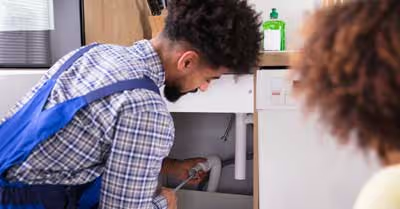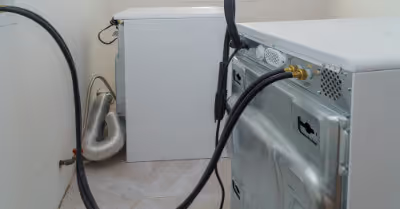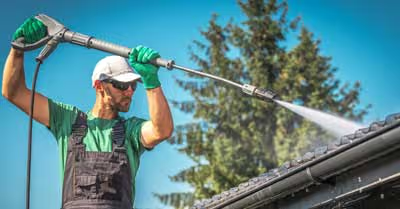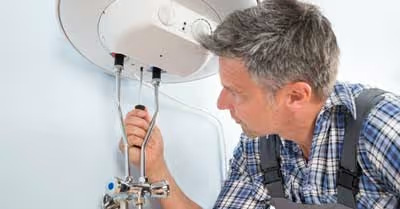Table of Contents
Hot Water Quickly Runs Out
This is a common problem and could just be a result of a water heater that is too small. The demand you ask of the water heater should rarely be more than 75% of the size of the appliance.
If it is too small you can limit hot water usage or get a larger unit. However, sometimes units quit producing enough hot water even if they are large enough.
Your best bet before getting into anything complicated is to turn up the thermostat. If that doesn’t work, the cause could be a defective heating element. If so, your solution will be to test the heating elements and then replace one if it is faulty.
No Hot Water
If you have no hot water at all, you should check the power first. Sometimes the water heater can trip the breaker switch and all you need to do is flip it back on.
It could also need a reset. To reset the high-temperature limit:
- Turn the breaker off so no power is reaching the appliance
- Take the access panel for the upper heating element off
- Remove insulation and the safety guard
- You should see a red button which is the reset button. It is located above the upper thermostat. Press it and then replace the safety guard, the insulation, and the panel.
- Turn the breaker back on
A good test is to touch the temperature-pressure relief valve and the hot water outlet pipe. If they feel warm, your heater is likely working and the water must be getting blocked in the pipes. It may be good to see if you have hot water in part of your house.
This could indicate a cross connection which is when cold water passes into the hot water side of a faucet. It could also be mineral deposits partially or fully blocking your pipes. Another thing to consider is the weather because it can cool down hot water or even freeze your pipes and restrict the flow.
If this doesn’t work, you should turn up the thermostat slowly to test the effectiveness. However, it could be a heating element so you may have to test each one. See the sections on testing and replacing the elements to find out how!
How Water Not Hot Enough
Usually adjusting the thermostat will fix this problem. You can find out how to do this in the thermostat section below. However, there is another cause of lukewarm water that you should consider.
Water heaters have a dip tube that supplies cold water to the tank. If it is damaged, you can end up with lukewarm water because the cold water will flow into the top of the tank instead of the bottom. It is possible to replace the dip tube, but if your water heater is getting towards the end of its lifespan (water heaters typically last 10 to 15 years), then you should consider replacing the appliance.
Water Leaks
Leaks in your water heater are usually caused by leaking valves, tank problems, or faulty plumbing connections. Leaks are more than a nuisance, they can cause serious damage to your home.
The elements could be loose or the tank could have deteriorated due to corrosion. You should always check the elements first to make sure they are tight enough. If not, tighten them with an element wrench.
If the tank is corroded, you will have to buy a new one. To stop the leaking, turn off all power to the water supply and drain the water heater tank.
Rust and Odor
If your water has a rust color hue, then there could be water tank corrosion or possible rust in your pipes. As stated above, a corroded water heater tank must be replaced. You may be able to help it with a water softener or water filtration system.
If your water has a strong egg smell, you could have bacteria in your hot water heater tank. This may require a professional plumber, but the odor is often caused by a corroded anode rod.
You can replace the anode rod by following these steps:
- Turn off the water heater and drain the tank until it is only part full
- Remove the anode rod
- Use teflon tape on any threads and insert the new anode rod making sure to sufficiently tighten it
- Refill the tank
- Turn the water heater on and you shouldn’t have a rotten egg smell anymore
Noisy Tank
Is your water heater making popping sounds, a rumbling noise, or a high pitched squeal? These could be the sound of boiling water.
If you have a sediment buildup on the bottom of your water heater tank, it can overheat. This causes the water to boil and the sounds you are hearing.
First, you need to drain the tank to get rid of the sediment, but if that doesn’t help you will have to call a plumber or replace the tank entirely.
Thermostat - Turn Up the Heat
Your hot water heater should be between 122 and 140 degrees Fahrenheit. If your hot water heater is cooler than this, you could be running out early. Not only that, but it can also be a haven for bacteria that can cause pneumonia so make sure it is at least 122 degrees.
Make sure you do not turn it up too high because it can cause serious burns. Make small adjustments, test, and then make further small adjustments as needed.
Most water heater thermostats are adjusted in a similar way. This goes for both gas and electric heaters.
Sometimes the thermostat is behind an insulated access panel. Many electric water heaters have two thermostats. If this is the case, one will be at the top of the tank, and the other at the bottom. Tankless water heaters should have a display with a temperature reading and adjustment controls.
You can use a thermometer to test the water coming out of your faucet before adjusting as well. Turn on the hot water and run it until it is completely hot. Then, hold the thermometer under the water until the temperature gauge stops going up.
If you have a digital thermostat, just push the buttons up or down accordingly. Many water heaters, however, have a dial thermostat at the bottom of the appliance.
Still others will be different and you need to follow a few simple steps:
- Go switch off the water heater at the circuit breaker
- Find your access panel and peel back the insulation under the cover
- Use a flathead screwdriver to adjust the temperature. If your water heater has two thermostats you should adjust them the same amount, but the top should be a little hotter than the bottom
- Replace insulation and panel cover
- Turn the power back on
- For gas, relight the pilot light
Wait 3 hours and test the water temperature. Then you can adjust it more in small increments until it suits your needs.
Test the Elements
Most water heaters have two heating elements. The power enters the top and runs to the cutoff switch. Then, the power will travel to the thermostats and elements. The top and bottom elements typically have separate thermostats.
When the water at the top of the tank is hot, the top element will switch off and the lower one heats up. Both elements should never come on at the same time.
fFirst, as with any water heater repair you need to turn off the power at the circuit breaker. Then,to test the elements you first have to get to them. Remove the metal cover that is usually near the bottom of the water heater unit.
You will see wires that are leading into the heater. Test their voltage with a no-contact voltage tester. This will make sure it is safe to continue your repair.
Now you need to disconnect the wires from the terminal heads. You will clip your clamp onto the element screws and use the tester to touch the other screw. If the element is working, the tester will light up, if not replace it.
Sometimes, there is a short circuit in the unit. To test for this, you will put the clamp on an element screw. Then, touch the tester to the bracket that mounts the element. If the light comes on now, you have a short and need to replace the element.
Installing a New Element
To replace an element, you need to remove the old one. To do this you have to close the cold-water inlet valve and open the hot water faucet in the kitchen.
Now, connect a regular garden hose to the drain and drain tank. Once the tank is drained you can remove the element by unscrewing it with an element wrench.
Once you have the faulty element out, you can install the new one. Always use elements that have the same wattage as the ones you are replacing. If you can’t find it on your old elements, you should be able to find it on the heater or in the instruction manual. If all else fails, you can likely find the correct wattage online.
To install the new element, simply screw it in using an element wrench and reconnect the wires. You should always double check the connections to make sure they are tight. Replace the insulation and covers.
Help for Gas Heaters
It is important that if you ever smell gas, call a professional and get out of the house.
Sometimes repairing a gas water heater is as easy as relighting the pilot light. Sometimes it can be put out by breeze through a vent or window. The fix for the pilot light depends on the reason it went out in the first place.
Relight instructions will appear on the side of the water heater. You will need to remove the cover which should be located near the bottom of the unit. You likely have two knobs, one for control and one for temperature. Both should be set to “Pilot.”
You need to push the control knob while using a long match or lighter to ignite the pilot light. Keep holding the knob down for a minute after it is lit. This lets all the air come out of the line. If you have automatic igniter, you will do the same thing except instead of using a match or lighter you will use the striker.
If the light flickers but goes out, the pilot orifice could be dirty. To clean it you have to turn off the gas supply to the water heater. There should be a valve that you can use to shut off the gas to the unit.
Now, you will remove the orifice fitting from under the access panel. Just twist it to the left. Then, unscrew the orifice and pull it away from the fitting. You can clean all of the components with a cotton swab and rubbing alcohol. Reverse the removal steps to replace the orifice, then try lighting the pilot again.
If the pilot light goes out when you stop pushing on the control knob, you probably have to replace the thermocouple. The thermocouple shuts off gas flow for safety, but if it is damaged it may not work correctly.
The thermocouple looks like a copper tube and connects the control panel to the burner behind the control panel. Always shut off the gas before repairing. You will need to release the burner assembly to remove the thermocouple, pilot light, and gas supply tubes. Install the new one and slide the burner assembly back into place. Now you should be able to reignite the pilot light.
If your pilot light burns yellow instead of blue, you have the wrong ratio of gas to air. You should know that this could signal that carbon monoxide is leaking and if you suspect it is, call the gas company and leave the home.
To diagnose the problem with the gas and air ratio, you should check for breezes because sometimes stopping the draft is a quick fix. However, if it doesn’t work you may have to call a professional.
Sometimes the issue is with the gas line. You should check if the gas valve is open or closed and look for any wrinkles that could cause an issue. Sometimes the gas company will temporarily shut the gas off to an area so it is a good idea to call and check. If that isn’t the issue, it may be time to contact an expert.
Recent Articles
















